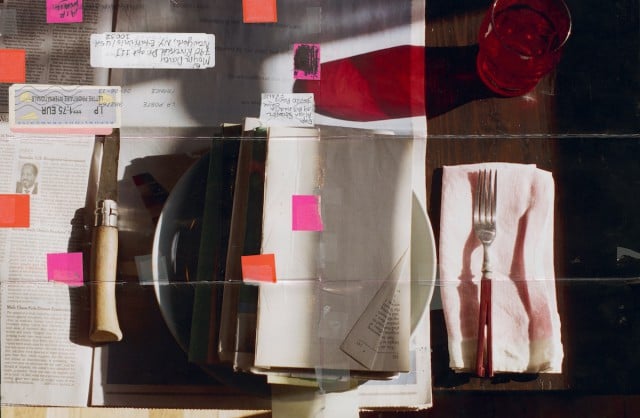Art & Exhibitions
Moyra Davey Gets Physical with Photos
THE DAILY PIC: Davey's photos explore just how material our images really are.

THE DAILY PIC: Davey's photos explore just how material our images really are.


Today’s Daily Pic is just a reproduction of a work of art. I need to keep that front and center as I discuss “Ruby Glass”, a piece by Moyra Davey that’s in her important solo show of new work at the Institute of Contemporary Art in Philadelphia. Davey’s photos are thin poster-style prints that she’s mailed off to various friends and colleagues. They get folded-up and taped so that they form their own envelopes, then stamped and addressed. Once Davey receives the prints back from her correspondents (I wonder if some refuse to give up their gifts?) she unfolds them and pins them to the walls of the spaces where she’s showing. One point of all this, it seems to me, is to emphasize the utter materiality of the photographic object as it circulates in the world–an emphasis that’s especially important at just the moment when so many people are pointing toward photography’s increasing virtuality. Davey’s prints may be making some kind of claim that physical objects caught up in a web of human interactions are more potent and interesting than free-floating immaterial images. It’s worth noticing that her photos (including the one only reproduced in today’s Pic) almost always depict worn and distressed surfaces and objects, or the scruffy artists’ spaces that such objects live in, as though those “hand rubbed” objects and spaces were the most worthwhile ones to contemplate. And the prints that she mails only come into their own–only become fully visible–once a pair of human hands has cut their tape and undone their folds, so that the creased and stamped prints become a unique record of the human interaction that they participated in. They are a direct “index”, as the theorists say, of that interaction, and can’t be effectively replaced by a mere picture or reproduction that carries the same image.
Ever since the arrival of quality art reproductions, and doubly with the advent of computer screens, we tend to think that all the different versions of an image we see, whether in a book or magazine or on a computer or smart-phone screen, are more or less interchangeable–as though the image floats free of its support to become just a scene in the world that was once glimpsed a certain way. Davey’s images fight against that impression, helping to make clear that all pictures live in an entirely physical world: They can only be seen by a human’s fleshy eyes and brain, in a particular real place that they’ve come to through some kind of social machinery; they are always carried by some totally physical medium, whether photographic emulsion, ink on paper or some kind of very material electronic display that varies hugely in brightness and resolution and color. And all of those media, including the hard drives and circuits that carry our data, will eventually crumble to dust, as will Davey’s much manhandled prints. The virtuality of the 21st-century image is a fiction that Davey helps reveal as such. (Image courtesy Moyra Davey and Murray Guy gallery, NY)
For a full survey of past Daily Pics visit blakegopnik.com/archive.